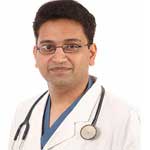
A ventricular septal defect (VSD) is a hole between the right and left pumping chambers of the heart.
The heart has four chambers: a right and left upper chamber called an atrium and a right and left lower chamber called a ventricle.
People with ventricular septal defects may not have symptoms. However, if the hole is large, the baby often has symptoms related to heart failure
The most common symptoms include:
- Hard breathing
- Fast heart rate
- Shortness of breath
- Sweating while feeding
- Frequent respiratory infections
A smaller hole may actually make a louder noise than a large hole, and the murmur may get louder as the ventricular septal defect closes.
Many times observation is the only treatment needed, with regular checkups with the cardiologist. This may be as infrequent as every two to three years in older children with small ventricular septal defects to as often as weekly in babies with large ventricular septal defects.
In babies who are failing to thrive because it is too difficult for them to eat, a high calorie formula or fortified breast milk will be added to help the baby grow.
Some ventricular septal defects may be closed using an FDA approved closure device which is placed using a heart catheter (a small plastic tube through which the device may be delivered).
BestHeartSurgery is a comprehensive information portal that gives both the common man and medical professionals.
